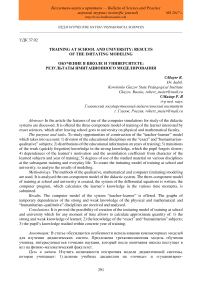Training at school and university: results of the imitating modeling
Автор: Mayer Robert
Журнал: Бюллетень науки и практики @bulletennauki
Рубрика: Педагогические науки
Статья в выпуске: 8 (21), 2017 года.
Бесплатный доступ
In the article the features of use of the computer simulations for study of the didactic systems are discussed. It is offered the three-component model of training of the learner interested by exact sciences, which after leaving school goes to university on physical and mathematical faculty. The purpose and tasks. To study opportunities of construction of the “teacher-learner” model which takes into account: 1) division of the educational disciplines on the “exact” and "humanitarian-qualitative" subjects; 2) distributions of the educational information on years of training; 3) transitions of the weak (quickly forgotten) knowledge in the strong knowledge, which the pupil forgets slower; 4) dependences of the learner’s motivation and the assimilation coefficient from character of the learned subjects and year of training; 5) degrees of use of the studied material on various disciplines at the subsequent training and everyday life. To create the imitating model of training at school and university, to analyse the results of modeling. Methodology. The methods of the qualitative, mathematical and computer (imitating) modeling are used. It is analysed the one-component model of the didactic system. The three-component model of training at school and university is created, the system of the differential equations is written, the computer program, which calculates the learner's knowledge in the various time moments, is submitted. Results. The computer model of the system “teacher-learner” is offered. The graphs of temporary dependences of the strong and weak knowledge of the physical and mathematical and “humanitarian-qualitative” disciplines are received and analysed. Conclusions. It is proved the possibility of creation of the imitating model of training at school and university which for any moment of time allows to calculate approximate quantity of: 1) the strong and weak knowledge of learner; 2) the knowledge of the “exact” and “humanitarian” subjects; 3) the pupil’s knowledge studied within concrete year of training.
Computer model, didactic system, imitating modeling, learning, training, pupil
Короткий адрес: https://sciup.org/14111713
IDR: 14111713 | УДК: 37.02 | DOI: 10.5281/zenodo.842963
Список литературы Training at school and university: results of the imitating modeling
- Атанов Г. А., Пустынникова И. Н. Обучение и искусственный интеллект, или Основы современной дидактики высшей школы. Донецк: Изд-во ДОУ, 2002. 504 с.
- Майер Р. В. Кибернетическая педагогика: Имитационное моделирование процесса обучения. Глазов: Глазов. гос. пед. ин-т, 2014. 141 с.
- Кудрявцев В. Б., Вашик К., Строгалов А. С., Алисейчик П. А., Перетрухин В. В. Об автоматном моделировании процесса обучения//Дискретная математика. 1996. Т. 8. №4. С. 3-10.
- Ивашкин Ю. А., Назойкин Е. А. Мультиагентное имитационное моделирование процесса накопления знаний//Программные продукты и системы. 2011. №1. С. 47-52.
- Аткинсон Р., Бауэр Г., Кротерс Э. Введение в математическую теорию обучения. М.: Мир, 1969. 486 с.
- Леонтьев Л. П., Гохман О. Г. Проблемы управления учебным процессом: математические модели. Рига, 1984. 239 с.
- Свиридов А. П. Статистическая теория обучения: монография. М. Изд-во РСГУ, 2009. 570 с.
- Разумовский В. Г., Майер В. В. Физика в школе: Научный метод познания и обучение. М.: Гуманитар. изд. центр ВЛАДОС, 2004. 463 с.
- Петров Ю. И. Некоторые подходы к моделированию обучаемого//Информационные технологии и проблемы математического моделирования сложных систем. Вып. 7. Иркутск: ИИТМ ИрГУПС, 2009. С. 176-185.
- Буль Е. Е. Обзор моделей студента для компьютерных систем обучения//Educational Technology & Society. 2003. №6 (4). С. 245-250.
- Mayer R. V. Computer-Assisted Simulation Methods of Learning Process//European Journal of Contemporary Education. 2015. V. 13. №3. P. 198-212 DOI: 10.13187/ejced.2015.13.198
- Майер Р. В. Компьютерные модели понимания и усвоения учебного материала//Дистанционное и виртуальное обучение. 2016. №8. C. 32-38.
- Шеннон Р. Имитационное моделирование систем: искусство и наука. М.: Мир, 1978. 302 с.


